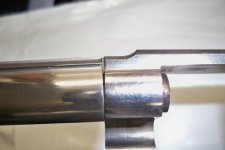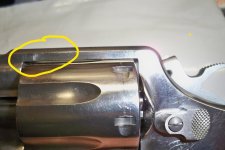(See post 24 in this thread for the resolution of my saga)
Like a few of you I couldn't resist the President's Day pricing at guns.com on their LEO trade in Model 65's. I posted earlier about info concerning where it might have come from based on markings Info please on my 65-4
A little over a week ago I took this Model 65 to the ranch and ran exactly 12 rounds through it - all of them over a chronograph. All were the same handload, with a 158 grain poly-coated lead bullet, producing an average velocity of 1157 fps with a small standard deviation and a high velocity of 1178 fps. Nothing unusual was noted and all shots were on a metal target at seven yards.
After the 12th shot the cylinder released with great difficulty requiring a sharp rap of the heel of my hand. Upon examination the barrel was at a discernible angle of several degrees down relative to the topstrap and the barrel had a very obvious separation from the frame at the topstrap.
There is no possibility of a double charge of powder. A double charge would have more than filled the case and that did not occur. Further, all velocities were under 1178 fps and no pressure signs were observed in any of the fired cases. The cylinder remains in excellent shape.
I examined this revolver carefully when it was received. There was a noticeable gap between the barrel and frame adjacent to the topstrap larger than any other S&W revolver I own but it did not seem alarming - perhaps it should have (it can be seen in the photos of my previous thread). The timing of the revolver appeared in perfect order before I fired the 12 rounds and nothing out of the ordinary was noted during the discharge of those 12 rounds.

I'm no expert but I'm pretty sure this Model 65 is now a paperweight

The downward cant of the barrel as indicated by the still intact ejector rod.
I had no intentions of feeding this Model 65 anything like a steady diet of .357 magnum loads. I've learned through this forum that the K-frame .357's aren't meant for that but the occasional moderate .357 load should be fine and stick with projectiles weighing more than 125 grains. That's what I did; I loaded some fairly moderate .357 cartridges to see what I had. I accomplished that goal; I know what I have.
Is it possible that the years this revolver spent at the correctional facility in Central Pennsylvania were tough ones digesting a good amount of full-power .357 magnum loads? Is it further possible that over time that diet took its toll? It's hard for me to characterize this as anything except an accident waiting for a time and place to happen.
The good news, especially for all of you who may have purchased one of these from guns.com, is that they appear to be standing behind it. Despite being beyond their three day return policy limit they have asked me to return the firearm and have sent the necessary materials to do that. I am grateful to guns.com for their concern.
Be careful.
Bryan
Like a few of you I couldn't resist the President's Day pricing at guns.com on their LEO trade in Model 65's. I posted earlier about info concerning where it might have come from based on markings Info please on my 65-4
A little over a week ago I took this Model 65 to the ranch and ran exactly 12 rounds through it - all of them over a chronograph. All were the same handload, with a 158 grain poly-coated lead bullet, producing an average velocity of 1157 fps with a small standard deviation and a high velocity of 1178 fps. Nothing unusual was noted and all shots were on a metal target at seven yards.
After the 12th shot the cylinder released with great difficulty requiring a sharp rap of the heel of my hand. Upon examination the barrel was at a discernible angle of several degrees down relative to the topstrap and the barrel had a very obvious separation from the frame at the topstrap.
There is no possibility of a double charge of powder. A double charge would have more than filled the case and that did not occur. Further, all velocities were under 1178 fps and no pressure signs were observed in any of the fired cases. The cylinder remains in excellent shape.
I examined this revolver carefully when it was received. There was a noticeable gap between the barrel and frame adjacent to the topstrap larger than any other S&W revolver I own but it did not seem alarming - perhaps it should have (it can be seen in the photos of my previous thread). The timing of the revolver appeared in perfect order before I fired the 12 rounds and nothing out of the ordinary was noted during the discharge of those 12 rounds.
I'm no expert but I'm pretty sure this Model 65 is now a paperweight
The downward cant of the barrel as indicated by the still intact ejector rod.
I had no intentions of feeding this Model 65 anything like a steady diet of .357 magnum loads. I've learned through this forum that the K-frame .357's aren't meant for that but the occasional moderate .357 load should be fine and stick with projectiles weighing more than 125 grains. That's what I did; I loaded some fairly moderate .357 cartridges to see what I had. I accomplished that goal; I know what I have.
Is it possible that the years this revolver spent at the correctional facility in Central Pennsylvania were tough ones digesting a good amount of full-power .357 magnum loads? Is it further possible that over time that diet took its toll? It's hard for me to characterize this as anything except an accident waiting for a time and place to happen.
The good news, especially for all of you who may have purchased one of these from guns.com, is that they appear to be standing behind it. Despite being beyond their three day return policy limit they have asked me to return the firearm and have sent the necessary materials to do that. I am grateful to guns.com for their concern.
Be careful.
Bryan
Attachments
Last edited:



